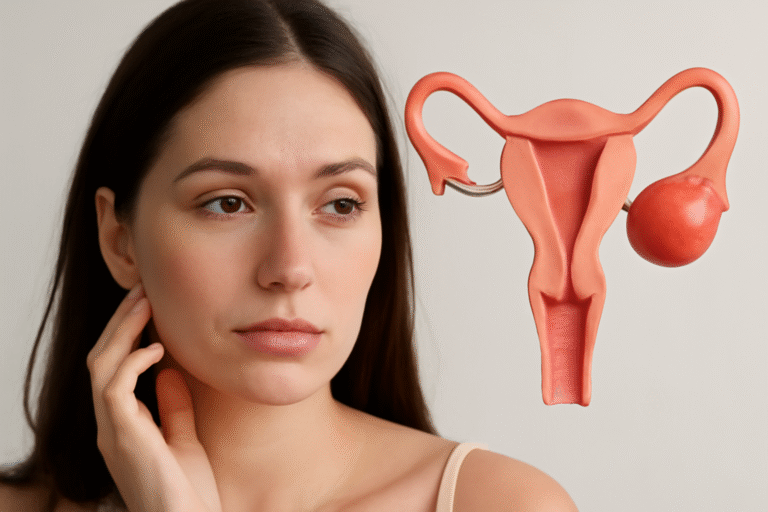Understanding and improving antral follicle count (AFC) can be a game-changer for women who want to get pregnant, whether naturally or with the use of assisted reproductive technologies. This important fertility marker, which is examined with a transvaginal ultrasound during the early follicular phase (usually days 2–5 of the menstrual cycle), gives a direct look at the small, fluid-filled sacs (2–10mm in diameter) in your ovaries that each hold an immature egg. AFC is different from previous ovarian reserve tests that use blood indicators since it gives you a real-time visual assessment of your ovarian capacity. A high antral follicle count usually means that the ovarian reserve is healthier, which means that the odds of getting pregnant and having a healthy pregnancy are better. Age is still the most important thing that affects AFC (counts typically drop as women get closer to their late 30s and 40s), but a new study shows that specific lifestyle changes can help follicle growth and ovarian health. This complete guide will look at the best science-based ways to naturally raise your antral follicle count and provide you with actions you can take to improve your chances of getting pregnant
Understanding Antral Follicle Count
The antral follicle count is one of the best ways to tell how many eggs are left in the ovaries, but it means a lot more than just counting the eggs that are there. AFC is a great way to tell how fertile someone is right now and how fertile they might be in the future because each antral follicle could become an egg during a menstrual cycle. For women of childbearing age, doctors say that an AFC of 10 to 20 per ovary is normal; however, counts can be very different from person to person. AFC is important because it provides information about how ovaries can react to reproductive therapies. For example, women with higher counts usually have greater responses to ovarian stimulation during IVF cycles. But it’s vital to know that AFC only shows how many eggs there are; it doesn’t always tell you how good they are, which is also critical for getting pregnant. Recent research suggests that making some changes to your diet and lifestyle may help boost the number and quality of antral follicles. This gives women who want to improve their reproductive outcomes organically some hope.
Ideal Antral Follicle Count by Age
Understanding what’s normal for your age is essential. Here’s a general guideline:
| Age Range | Average AFC | Interpretation |
| 20–29 | 15–30 | Excellent |
| 30–34 | 12–25 | Good |
| 35–37 | 10–20 | Fair |
| 38–40 | 8–15 | Reduced |
| 40+ | 4–10 | Low |
Note: Numbers vary from person to person. Your AFC is just one piece of the fertility puzzle.
Nutritional Strategies to Boost Antral Follicle Count
The Power of Antioxidants for Ovarian Health
More and more studies show that antioxidants are very important for protecting ovarian follicles from oxidative stress, which is one of the main causes of a lower ovarian reserve. Free radicals can induce oxidative damage that speeds up follicular atresia, which is the natural process of follicle degeneration. This could lower your antral follicle count over time. Eating a range of foods that are high in antioxidants every day can help fight this harm. Blueberries, raspberries, and blackberries are very good for you since they have a lot of anthocyanins and vitamin C. Lutein and zeaxanthin are found in dark leafy greens like spinach and kale. Nuts and seeds are good sources of vitamin E and selenium, which are all important for keeping follicles healthy. A 2019 study in the Journal of Ovarian Research discovered that women who ate more dietary antioxidants had much greater ovarian reserve markers, such as AFC, than women who ate fewer antioxidants.
Essential Fatty Acids: Building Blocks for Reproductive Hormones
There is a strong link between good fats and reproductive health. Omega-3 fatty acids are especially necessary for the formation of follicles. These important fats help keep inflammation in check, make the best circumstances for follicles to mature, and are needed for hormone production. Wild-caught salmon, sardines, and mackerel are all fatty fish that are great providers of EPA and DHA, which are the most accessible forms of omega-3s. Flaxseeds, chia seeds, and walnuts are good sources of alpha-linolenic acid (ALA) for vegetarians and people who don’t eat fish. The body can turn some of this into EPA and DHA. Avocados and extra virgin olive oil are two more foods that are high in monounsaturated fats that help keep hormones in balance. A clinical trial in 2020 showed that women who took omega-3 fatty acids for at least three months had higher antral follicle counts and other signs of ovarian reserve. This suggests that these nutrients may help keep follicles from dying and even make them more likely to grow.
Protein Quality and Its Impact on Follicle Development
The kind and quality of protein you eat can have a big effect on how well your ovaries work and how healthy your follicles are. Complete proteins that have all the required amino acids are especially critical for helping cells divide quickly during follicular development. Eggs are one of the finest foods for fertility because they provide the right amount of protein and a lot of choline, which is a nutrient that is important for cell membranes to work properly. Lentils, chickpeas, and quinoa are examples of plant-based proteins that also have fibre and phytonutrients that help the body break down estrogen. Recent studies suggest that replacing some animal proteins with plant-based ones may be good for reproductive health. For example, one study found that women who ate more plant proteins had improved ovarian reserve characteristics. But moderate amounts of high-quality animal proteins like grass-fed beef, pasture-raised chicken, and wild-caught fish can give you key nutrients like iron, zinc, and vitamin B12 that are very critical for the best follicular growth.
Also Read: What Is AFC
Lifestyle Modifications to Enhance Antral Follicle Count
The Detrimental Impact of Chronic Stress on Ovarian Reserve
More and more scientific papers are showing that there is a link between chronic stress and lower ovarian reserve. When the body is under stress for a long time, high amounts of cortisol might throw off the delicate balance of reproductive hormones, which could compromise follicular growth and ovulation. This stress response may change the release of gonadotropin-releasing hormone (GnRH), which in turn changes the production of follicle-stimulating hormone (FSH) and luteinizing hormone (LH). All of these hormones are necessary for the correct maturation of follicles. Using stress-reduction practices every day can help lessen these consequences. Mindfulness-based stress reduction (MBSR) programs that include meditation and moderate yoga have shown a lot of potential in research on fertility.
Sleep Optimization for Hormonal Balance
When talking about ways to raise antral follicle count, it’s important to stress how closely sleep quality and reproductive health are linked. The body does important repairs and controls important reproductive hormones while you are in a deep sleep. Melatonin is widely known as a sleep hormone, but it also protects developing follicles in the ovaries from oxidative damage. Women who don’t get enough sleep or sleep at odd times are likely to have lower ovarian reserve markers. Try to get 7 to 9 hours of good sleep every night. Keeping the bedroom chilly (about 65°F or 18°C), fully dark, and devoid of electronic gadgets at least an hour before bed can make a big difference in the quality of your sleep. Women who have trouble sleeping may be able to bring their sleep habits back to normal.
Targeted Supplementation to Support Follicle Development
CoQ10: The Mitochondrial Booster for Egg Health
Ubiquinol is one of the best supplements for women who want to naturally increase their antral follicle count. This fat-soluble substance is very important for how mitochondria work since it gives the metabolic needs of growing follicles energy. As women get older, their natural levels shown CoQ10 go down. Which could affect the quality of their eggs and the growth of their follicles. In a major 2018 randomised controlled experiment, women who took CoQ10 supplements for 60 days before IVF had a lot more antral follicles. The body can change normal CoQ10 into ubiquinol, but the active version is easier to absorb.
Vitamin D: The Sunshine Vitamin’s Role in Ovarian Function
In the past several years, a lot of scientific evidence has come out that shows how important it is to get enough vitamin D for reproductive health. There are vitamin D receptors all over the reproductive system, even in ovarian tissue and growing follicles. This important vitamin controls the generation of anti-Müllerian hormone (AMH). Which affects the growth of follicles and helps keep estrogen levels in check. A lot of women don’t get enough vitamin D, especially those who live in northern latitudes. Studies show that keeping serum vitamin D levels between 40 and 60 ng/mL may improve reproductive results. Getting some sun will help raise vitamin D levels, but to get and keep the best levels for fertility. You usually need to take 2000 to 5000 IU of vitamin D3 every day. It’s best to take vitamin K2 alongside it to help your body absorb and use it better.
Environmental Factors and Their Impact on Antral Follicle Count
Reducing Exposure to Endocrine Disruptors
Toxins in the environment that we come into contact with every day. a It has big effect on ovarian reserve and antral follicle count by messing up how hormones work. Chemicals that mess with hormones, like bisphenol A (BPA), phthalates, and parabens, can mimic or block natural hormones. You can find these chemicals in a lot of things you use every day, like plastic food containers, personal care items. Being aware of your choices and making them can help keep your ovaries healthy. Use glass or stainless-steel containers to store food, don’t heat food in plastic, and use personal care items. Making these modifications may be especially crucial for women with low AFC for no apparent reason, as environmental variables may be affecting their ovarian reserve.
The Impact of Electromagnetic Fields (EMFs) on Ovarian Health
A new area of worry in reproductive health is how non-ionizing radiation from electronic gadgets can affect the function of the ovaries. Some studies suggest that being around electromagnetic fields (EMFs) from cell phones, laptops, and Wi-Fi routers for a long time may cause oxidative stress in reproductive organs. However, research is still ongoing. More research is needed to find the direct link to antral follicle count, although women who want to improve their fertility may want to take precautions.
Conclusion
While you can’t create new eggs, you can optimize ovarian health and potentially increase antral follicle count naturally with these strategies. Focus on a nutrient-rich diet, stress management, and targeted supplements to support fertility.
By making these changes, you’ll not only improve your AFC but also enhance overall reproductive wellness.




